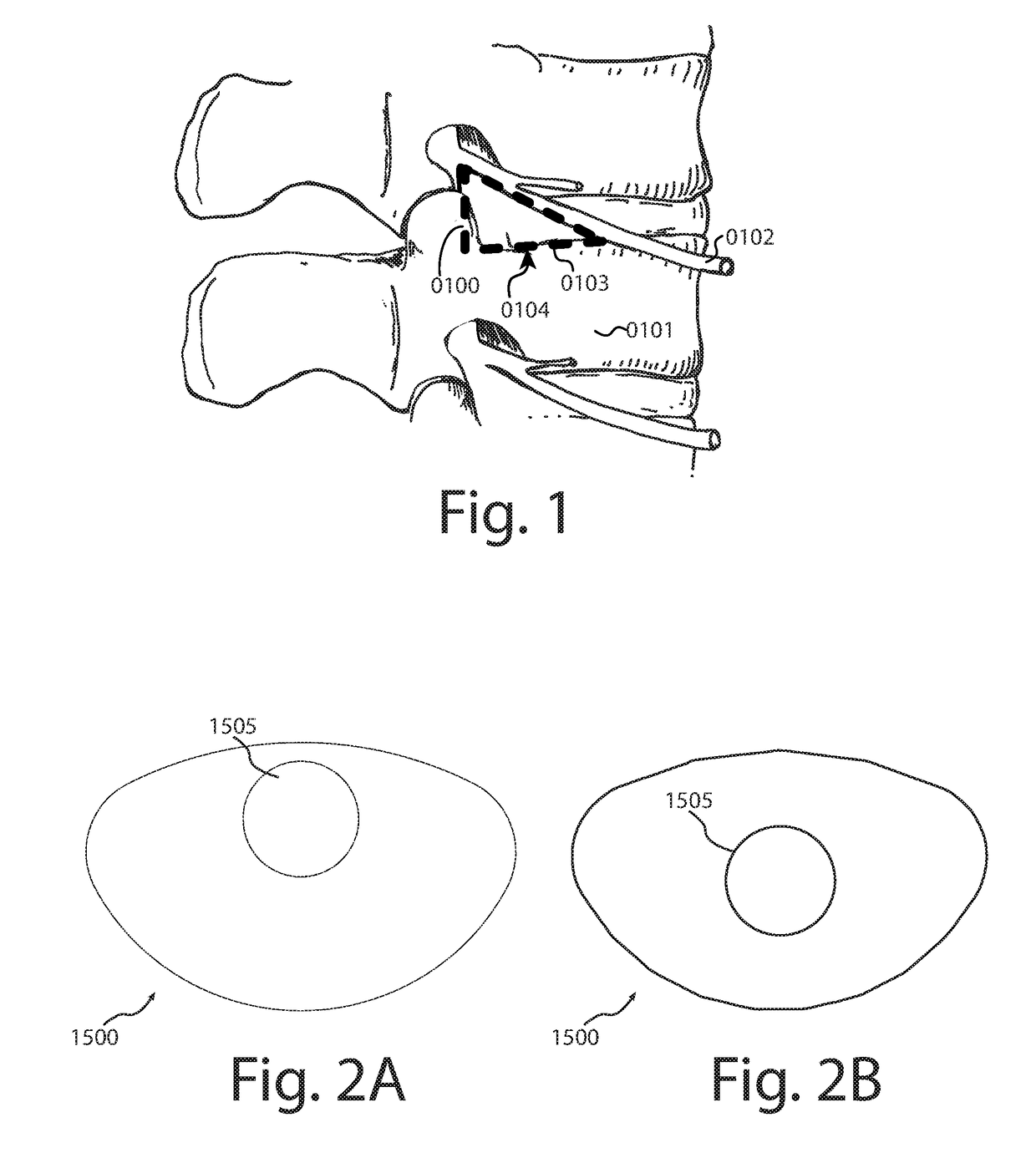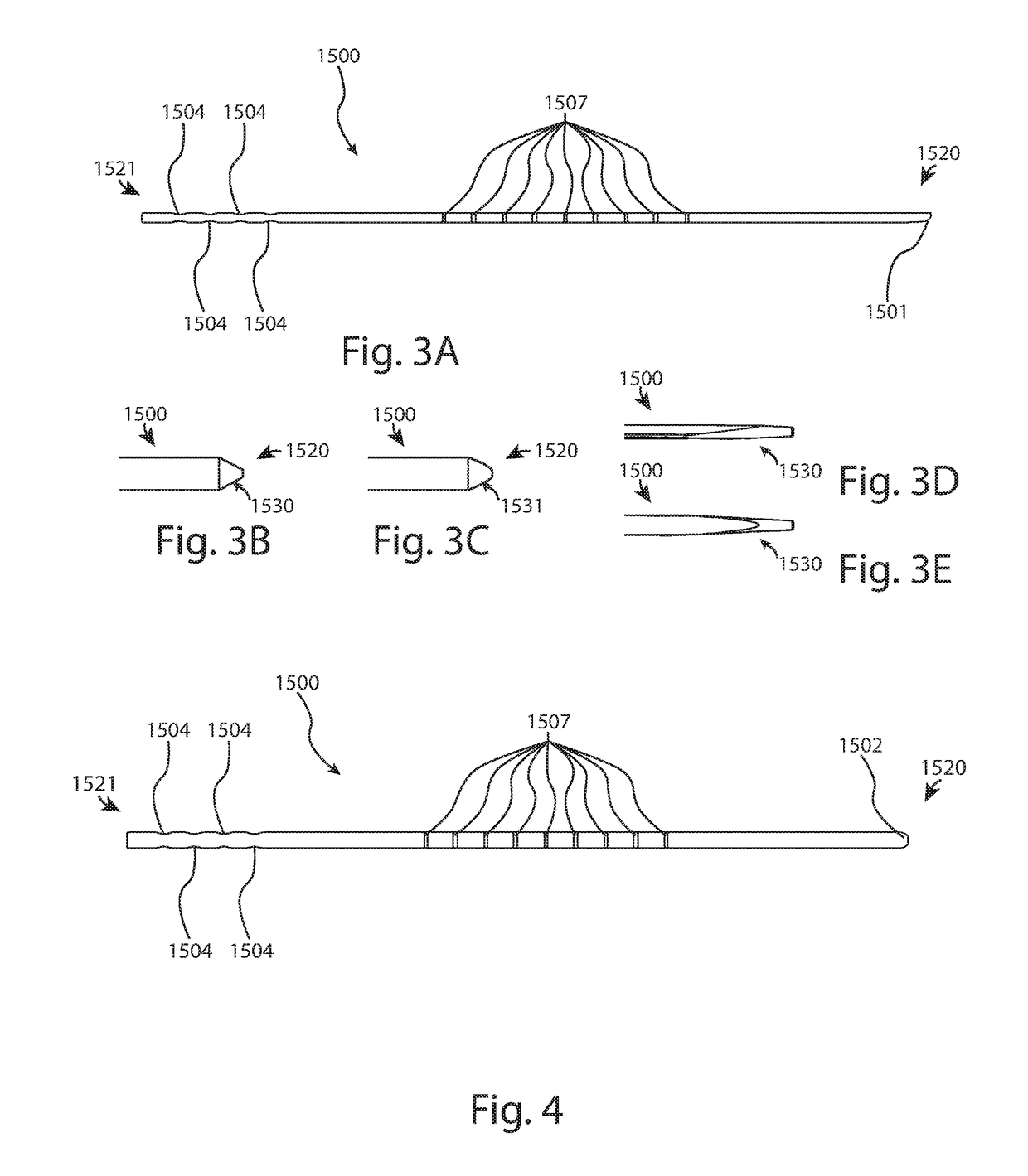The movement of one bony structure against another may lead to bone spurring which may impinge nerve structures and cause pain.
A problem associated with removing bony structures of the spine, however, is the reduction of the supportive bony tissue able to bear strain.
While after fusion, such procedures can effectively treat
pathology, the removal of bony supportive tissue elevates the risks to the patient if such a fusion fails.
Therefore, significant problems remain to be solved in association with the widespread use of the methods and apparatuses associated with TLIFs.
Several problems derive from the typically known access trajectories associated with prior art methods of creating an access corridor to the interbody space.
For instance, the surgeon's creation of a
route through the soft and other tissue on or near the trajectory from the
skin to the spine can cause damage to those and related tissues.
A problem associated with the
discectomy step, however, is that the tools and steps have heretofore not adequately been developed to accomplish an optimal
discectomy via an oblique approach traversing the area of Kambin's Triangle through a tube of 10 millimeters or less.
A problem associated with the decortication step, however, is that the tools and steps have heretofore not adequately been developed to accomplish an optimal decortication via an oblique approach traversing the area of Kambin's Triangle through a tube of 10 millimeters or less.
A problem associated with the deposition of bone graft material step, however, is that the tools and steps have heretofore not adequately been developed to accomplish an optimal deposition of bone graft material via an oblique approach traversing the area of Kambin's Triangle through a tube of 10 millimeters or less.
A problem associated with this procedure is that the associated generally anterior path comes within the vicinity of the
great vessels, which carries a risk of aortic vascular laceration and bleeding out.
A problem associated with this procedure is that after the nerves can be seen, the surgeon retracts them to one side, a step which carries a
high incidence of nerve bruising or damage.
A problem associated with this procedure is that because of the TLIF approach angle, the surgeon is generally required to remove part of or the entire
facet joint of the spine in order to visualize the vertebral bodies and interbody space and to remove the disc material.
As a result of the removal of at least part of a
facet, increased spinal
instability can result.
Accordingly, if the associated vertebral bodies do not fuse following the procedure, the patient will experience chronic instability as one side of the spine is supported by an intact
facet joint while the other is not.
Another problem is that in many cases, to accomplish a TLIF procedure, a surgeon must retract the dura to one side, increasing the likelihood of nerve damage.
The LLIF approach requires
dissection of the oblique abdominal
muscle structures and the psoas, posing risks to the patient.
A problem associated with the LLIF procedure is that because this approach is performed trans-psoas, the psoas and the nerve structures therein are retracted for long periods of time, increasing to the risk of nerve damage.
The resulting trauma to the psoas and
sensory nerve structures may produce frequent, undesirable post-operative side effects.
Despite the remarkable advantages of the OLLIF, many surgeons have been reluctant to adopt the technique due to the required passage through Kambin's Triangle, which may place one or more of the exiting nerves and / or nerve roots at risk.
A major problem associated with OLLIF is the trajectory near the nerves forming the boundary of Kambin's Triangle.
In previously-known OLLIF methods and systems, without protection against impacting the nerves of Kambin's Triangle, a
high incidence of associated nerve bruising or other nerve trauma has been known.
Prior art solutions utilizing the OLLIF approach have not yet solved the challenges associated with establishing a durable trajectory for passage of implantation and implants through a shielded approach with a sufficiently small
diameter to enable passage through Kambin's Triangle, protecting such implantation and implants from harming the nerves associated with Kambin's Triangle.
A related problem associated with the approach stems from the diminutive dimensions of Kambin's Triangle.
Further, the relatively smaller
footprint of implants traditionally associated with OLLIF may lead to a higher risk of
subsidence relative to the LLIF procedure.
A problem with the approach associated with prior procedures is that the dimensions of Kambin's Triangle allow for an approach trajectory path that is too narrow for many standard surgical instruments.
Despite being a potentially preferable approach to the spine, many surgeons are reluctant to utilize an approach near or through Kambin's Triangle to accomplish procedures related to the interbody space because instruments and / or implants are larger than those utilized during epidural injection-type procedures, and therefore
pose an
increased risk of contact nerves comprising or near to Kambin's Triangle.
A trajectory that traverses the ilium, but then travels above the Sacral Ala may lead to unintended deflection of
instrumentation superiorly and possibly into the
nerve root, causing damage to the nerves.
It is difficult, even for those skilled in the art, to comprehend the complex
anatomy and multiple geometries of the
sacrum, ilium and associated nerves at the L5-S1 junction.
Moreover, other approaches including that described in U.S. Pat. No. 8,790,406 to Smith fail to incorporate steps to target the
lower half of Kambin's Triangle at L5-51.
As such, this approach located superior to the Sacral Ala takes a path closer to, or in contact with, the
nerve root exiting L5, thereby causing risk.
Thus, such previously known approaches targeting the upper half of Kambin's Triangle place the L5
nerve root at risk.
A problem associated with the methods associated with previously known approaches is that the
instrumentation and implants following such methods often
brush off and are forced in a superior direction by the exterior surface of the Sacral Ala, resulting in a dangerous and undesirable method of
surgical approach leading to the risk of damaging or contacting the L5 nerve root.
 Login to View More
Login to View More  Login to View More
Login to View More 


